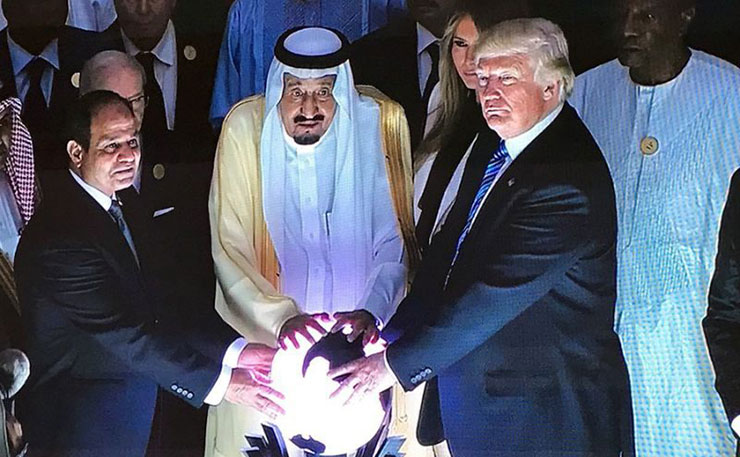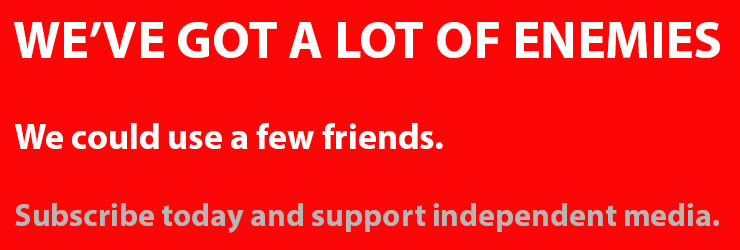With a few small twists, it’s business as usual for US foreign policy on the Middle East under Donald Trump, writes Michael Brull.
For many casual observers, the most significant thing about US President Donald Trump’s recent visit to Saudi Arabia will be the bizarre photo op he took with the dictators of Saudi Arabia and Egypt over a glowing orb. Yet Trump set out what we may expect to be the contours of his policy on the Middle East for at least the near future.
There are three primary things that Trump’s speech signalled. Firstly, that Trump’s tyrannical allies in the region are safe, and he will continue US support for them. Secondly, that Trump will use mean words about terrorism in the region, but does not regard it as a priority issue to address. Thirdly, that Trump intends to re-escalate tensions between the US and Iran. Fourthly, that the US intends to continue its support for the genocidal war on Yemen.
1. Business as usual: America’s tyrannical allies are safe
In his speech, Trump singled out for praise the loyal dictators in the region. Ticking them off one by one, he praised Saudi Arabia, Bahrain, Qatar, Kuwait, the United Arab Emirates and Jordan. Egypt was left out for some reason, but this was probably unintentional – Trump has warmly embraced Abdel Fatah el-Sisi, the oppressive dictator of Egypt.
Trump didn’t praise their human rights records – he claimed instead that they are “making significant contributions to regional security”, by fighting ISIS, supporting the US in Afghanistan, opposing Hezbollah, and in waging war on Yemen.
One might have thought Trump, the supposedly loose cannon, would offer a different performance if jihadi terrorism was a priority for him. After all, before he was elected, he blamed Saudi Arabia for the September 11 attacks.
Yet the US alliance with Middle Eastern tyrants – above all the Saudi royalty – has been sacrosanct in the US political system for decades, regardless of campaign rhetoric.
In June 2009, President Hope and Change himself, Barack Obama visited the Middle East. He called then Egyptian dictator Hosni Mubarak a “force for stability and good in the region”, and praised the “wisdom and graciousness” of the Saudi King.
Though he hadn’t tweeted about it, Obama had also spoken critically about America’s allies, connecting their oppression to the threat of terrorism. He said “Let’s fight to make sure our so-called allies in the Middle East, the Saudis and the Egyptians, stop oppressing their own people, and suppressing dissent, and tolerating corruption and inequality, and mismanaging their economies so that their youth grow up without education, without prospects, without hope, the ready recruits of terrorist cells.”
Obama’s warm relationship with the Saudis ran to the tune of $115 billion in arms sales. Trump’s new arms deal is to the amount of $109.7 billion. An impressive amount, to be sure, but not a change in US policy. As Derek H. Chollet, the assistant secretary of defence for international security affairs under Obama said, “I see this as largely continuity.”
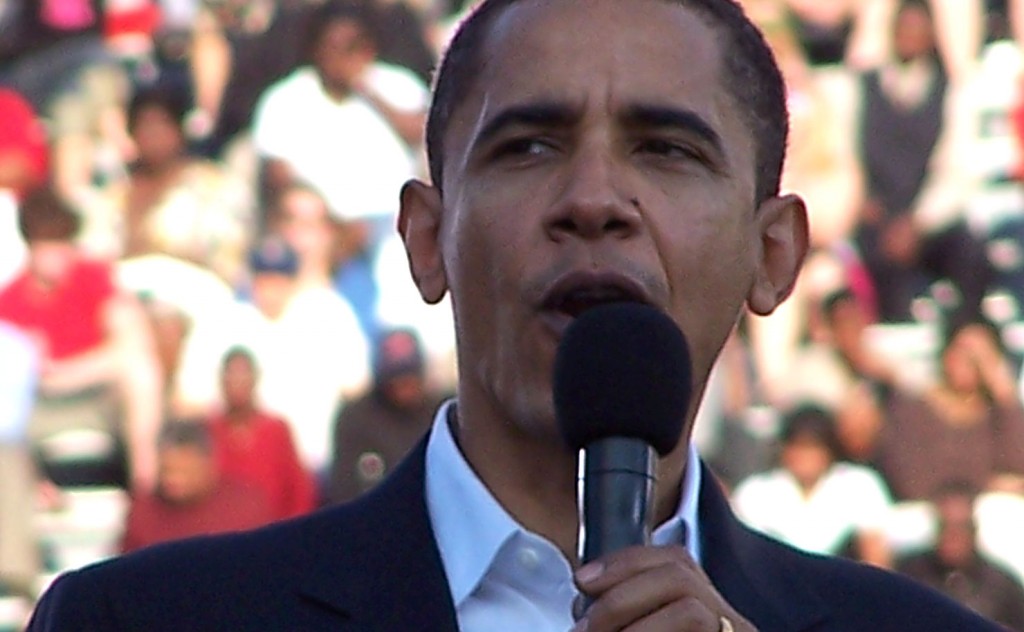
Some have expressed outrage that around the same time as the new arms deal, the Saudis announced a $100 million donation to a feminist charity run by Ivanka Trump.
Again, this isn’t so new for US Empire. Before Hillary Clinton became Secretary of State, the Saudi government gave $10 million to the Clinton Foundation. In 2011, Clinton sold almost $30 billion of arms, made by Boeing, to Saudi Arabia. Two months before that deal, Boeing had also given $900,000 to the Clinton Foundation.
Maybe all of these donations are a coincidence. Or maybe not. Regardless, this isn’t the kind of thing that Trump has invented.
2. Mean words about terrorism, instead of re-examining our allies
Trump shows no signs of making counter-terrorism a priority of American policy. He did, however, use angry rhetoric: “Drive them out of your places of worship… Drive them out of this earth”. In the end, he lumped together Hamas and Hezbollah with ISIS and al Qaeda, and suggested that Iran is the primary supporter of terrorism in the region.
As Trump knows, if any government should be singled out for supporting jihadis, it is the Saudi government. 15 of the 19 hijackers on 9/11 were Saudi. Osama Bin Laden was Saudi. In 2014, Hillary Clinton sent an email based on intelligence sources. It observed that “the governments of Qatar and Saudi Arabia… are providing clandestine financial and logistic support to ISIL and other radical Sunni groups in the region.”
This wasn’t new. In a 2009 memo, she wrote that “donors in Saudi Arabia constitute the most significant source of funding to Sunni terrorist groups worldwide.” Alas, “it has been an ongoing challenge to persuade Saudi officials to treat terrorist financing emanating from Saudi Arabia as a strategic priority.” Whilst the Saudis had supposedly made progress, “more needs to be done since Saudi Arabia remains a critical financial support base for al-Qa’ida, the Taliban, LeT, and other terrorist groups, including Hamas”.

Former Vice President Joe Biden has made similar complaints. Biden said:
“Our allies in the region were our largest problem in Syria. The Turks were great friends, and I have a great relationship with Erdogan, [who]I just spent a lot of time with, [and]the Saudis, the Emirates, etcetera.
What were they doing? They were so determined to take down Assad, and essentially have a proxy Sunni-Shia war, what did they do? They poured hundreds of millions of dollars and tens of tons of weapons into anyone who would fight against Assad – except that the people who were being supplied, [they]were al-Nusra, and al-Qaeda, and the extremist elements of jihadis who were coming from other parts of the world.
Now, you think I’m exaggerating? Take a look. Where did all of this go? So now that’s happening, all of a sudden, everybody is awakened because this outfit called ISIL, which was al-Qaeda in Iraq, when they were essentially thrown out of Iraq, found open space and territory in [eastern]Syria, [and they]work with al-Nusra, who we declared a terrorist group early on. And we could not convince our colleagues to stop supplying them.”
Biden apologised for this supposed gaffe. Not because it was untrue, but because the interests of the US Empire take precedence over the threat of anti-Western terrorism, which don’t rate as a priority. Likewise for the US invasion of Iraq in 2003. As the Chilcot Inquiry re-confirmed, the UK and the US went into the invasion knowing perfectly well it would increase the threat of terrorism against them. Britain’s Joint Intelligence Committee wrote in February 2003: “The threat from Al Qaida will increase at the onset of any military action against Iraq.”
Some may be surprised that Trump didn’t continue with his overtly anti-Muslim rhetoric. Yet the War on Terror has always been about finding rhetoric to denounce our enemies, without challenging or destabilising our allies, or jeopardising our interests. Hence, “They Hate Us For Our Freedoms”.
3. Iran is bad
The most important innovation of Trump’s speech was his demonisation of Iran. Trump said that, “Iran funds, arms, and trains terrorists, militias, and other extremist groups that spread destruction and chaos across the region. For decades, Iran has fuelled the fires of sectarian conflict and terror.” Put aside that these charges could more appropriate be laid at the allies Trump glorified in his speech. Trump singled out Iran’s roles in Yemen, Lebanon, Iraq and Syria.
In Syria and Iraq, Iran is partially on the side of the US. ISIS operates in Iraq and Syria, and it has repeatedly engaged in sectarian slaughter of Shia Muslims, who it loathes. In Syria, Iran has backed the Syrian government of Bashar al Assad, and the Lebanese militia Hezbollah. They have fought the insurgency against Assad, but they have also fought ISIS.
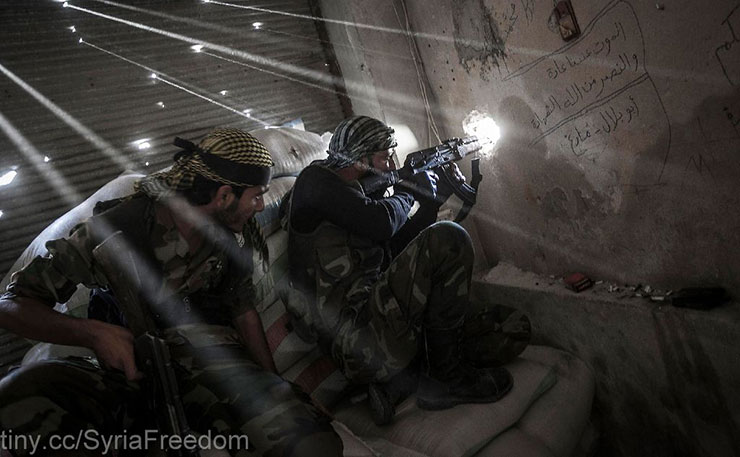
A recent report by the IHS Jane Terrorism and Insurgency Centre found that 43 per cent of ISIS’s battles from April 2016 to March 2017 were fought against the Syrian army and its allies. That is, if Syria was viewed solely through the prism of militarily fighting terrorism, Trump would ally with Iran and Assad against ISIS.
Indeed, in November, this was Trump’s position. Trump said “I’ve had an opposite view of many people regarding Syria. My attitude was you’re fighting Syria, Syria is fighting ISIS, and you have to get rid of ISIS”. He didn’t like Assad, but he also didn’t think US support for the insurgency was wise, as “we have no idea who those people are”.
Trump now backs a plan to arm the Kurds in Syria directly. This doesn’t make US policy any more coherent. It seems Trump’s policy is supporting all parties continuing the civil war in Syria, and letting the carnage go on, as his adversaries weaken each other.
In Iraq, the fight against ISIS is led by the Kurds, US firepower, and Iranian-backed Shia militias. Foreign Minister Julie Bishop has improved ties with Iran, and made what is now an impolitic admission – in the war on ISIS in Iraq, the US has worked with Iran. It is not clear how Trump would fight ISIS without Iran’s support – or if he realises the leverage they have against the US.
In aligning with the Sunni dictatorship, Trump appears to prioritise re-isolating Iran and undoing the agreement it worked out with the Obama administration. Mehdi Hasan observed that Trump already went to the brink of war with Iran in February. Hasan also noted that the Trump administration is packed with Iran hawks.
This is different to the Obama administration, but not so innovative either. In 1979, the Iranian people committed a terrible crime against the US, by overthrowing their US-backed dictator. In January 1980, President Jimmy Carter issued what became known as the Carter Doctrine. Carter announced that, “An attempt by any outside force to gain control of the Persian Gulf region will be regarded as an assault on the vital interests of the United States of America, and such an assault will be repelled by any means necessary, including military force.”
American historian Andrew Bacevich explained that this meant turning the Persian Gulf into an “informal American protectorate”. Policymakers understood that “the principal threats to Persian Gulf stability came from states. The key to maintaining access to the region’s oil reserves, therefore, was to make states behave.”
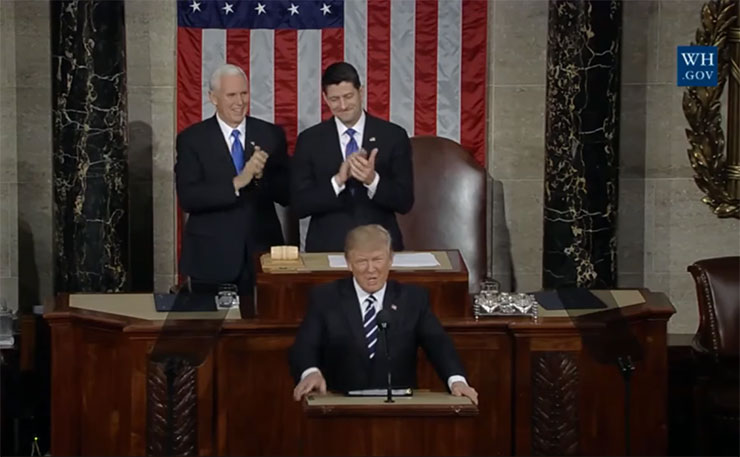
That is, one of the primary impetuses of American policy in the Middle East for decades has been about ensuring control of its oil resources. States that fail to bow to US power are ipso facto a threat. That is why the US has been aggressively hostile to Iran for decades. There was a brief reprieve at the end of the Obama administration, but the Trump administration’s hostility to Iran is – again – not a new development.
4. Green lighting the destruction of Yemen, ignoring al Qaeda
In his speech, Trump cheerfully announced his $110 billion arms deal with Saudi Arabia. He also conflated the war on Yemen with the fight against terrorism. That is, he said:
“Many are already making significant contributions to regional security: Jordanian pilots are crucial partners against ISIS in Syria and Iraq. Saudi Arabia and a regional coalition have taken strong action against Houthi militants in Yemen.”
Trump has begun his administration by selling to Saudi Arabia almost as much weaponry as Obama sold them over the course of eight years. It is worth recalling what this means for Yemen.
On April 12, the United Nations issued an appeal, warning that millions are on the “brink of famine…. We are in a race against time to save lives and prevent a full-scale famine unfolding in the country”. A World Food Program representative said that, “The situation is getting close to a breaking point in Yemen with unprecedented levels of hunger and food insecurity. Millions of people can no longer survive without urgent food assistance”. 6.7 million people face imminent famine.
According to UNICEF, 63 000 children had already died of diseases linked to malnutrition by January this year. The situation is poised to get even worse, as Saudi Arabia threatens an offensive on the port city of Hodeida. This threatens to tighten the blockade, which has already reduced most of Yemen’s population to despair, destitution and hunger.
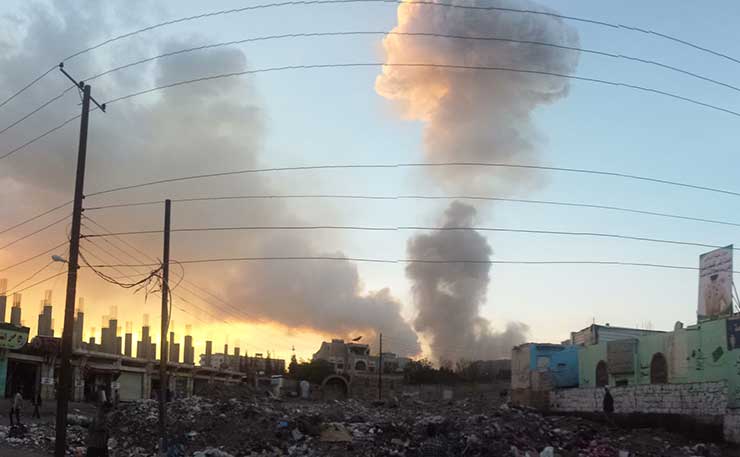
Put aside for a moment the morality of killing tens of thousands of children, and threatening millions of people with agonisingly awful deaths from famine. The Saudi backed government of Yemen is in exile, and the Houthis are dealing with an invading coalition of the richest Arab countries, backed by the world’s superpower and other rich Western countries. This has created a vacuum, which al Qaeda in the Arabian Peninsula (AQAP) has eagerly filled.
Middle East correspondent Patrick Cockburn commented last year that AQAP are the “real winners in this war”, as they have “taken advantage of the collapse of central government to create its own mini-state. This now stretches for 340 miles – longer than the distance from London to Edinburgh – along the south coast of Yemen. AQAP, which the CIA once described as the most dangerous protagonist of ‘global jihad’ in the world, today has an organised administration with its own tax revenues.”
Let me underline this point. Trump is backing a war which is threatening seven million people with famine, and strengthening the most dangerous branch of al Qaeda. Cockburn concluded his analysis by writing, “As has happened repeatedly since 9/11, the US and countries like Britain fail to combat terrorism because they give priority to retaining their alliance with Saudi Arabia and the Gulf monarchies, even when their policies – as in Yemen – wreck a whole country and enable al Qaeda and ISIS to use the chaos to establish safe havens.”
Some will react to Trump’s speech by announcing that he abandoned Islamophobic rhetoric. Yet rhetoric is not the primary means through which the US government oppresses Muslims. President George Bush gave lovely speeches rejecting the demonisation of Muslims and Islam. But he set up a torture camp, invaded two Muslim countries, and rendered Muslims around the world to oppressive countries which would torture them. Obama gave speeches with the kind of soaring rhetoric that liberals loved, whilst bombing Muslims in Pakistan, Yemen, Somalia, Afghanistan, Libya, Iraq and Syria. Indeed, Trump himself has noted that despite his many harsh critics in the media, they’ve been delighted with his foreign policy. Trump has won those plaudits by bombing targets of the Syrian army twice, and dropping the obscenely named “Mother Of All Bombs” on Afghanistan.
Whilst Trump should be criticised for his overtly racist rhetoric, his policy of supporting a genocidal war on Yemen is by far his most evil policy. Yet that war is also backed by the Democrats, and many other Western governments, including our own.
Whilst hostility to Iran is the biggest shift in Trump’s speech, the green light it gave to the destruction of Yemen may be its most important legacy.
Donate To New Matilda
New Matilda is a small, independent media outlet. We survive through reader contributions, and never losing a lawsuit. If you got something from this article, giving something back helps us to continue speaking truth to power. Every little bit counts.

